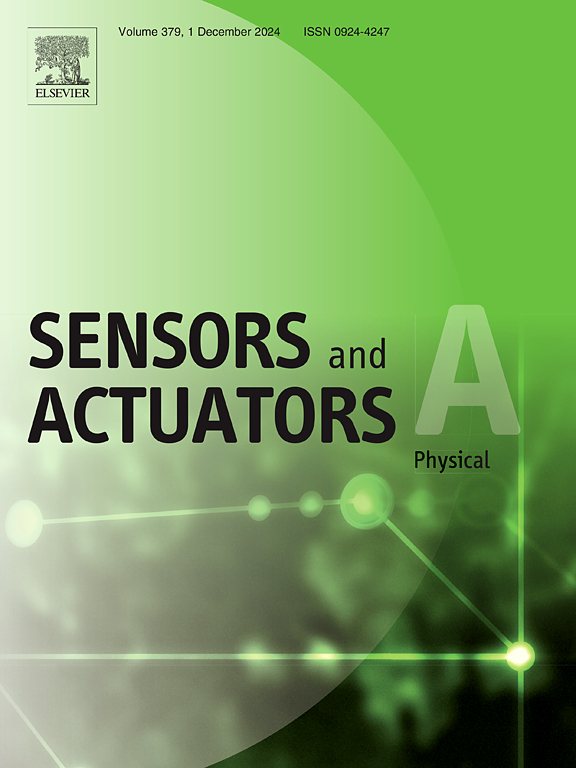可折叠柔性关节执行器,超低工作气压
IF 4.1
3区 工程技术
Q2 ENGINEERING, ELECTRICAL & ELECTRONIC
引用次数: 0
摘要
气动关节执行器是机器人系统的重要组成部分,使软机器人能够复制在动物和人类中观察到的自然运动,如抓取,行走和游泳,通过气动驱动产生旋转变形。然而,传统的联合执行器通常需要高工作压力(≥5 kPa),这导致系统结构复杂,能耗高。基于蜘蛛式液压关节的折叠膜结构,设计了一种新型气动关节驱动器。该可折叠柔性关节执行器将两个弹性气室与折叠膜结构集成在一起,折叠膜的膨胀驱动弹性气室的变形,在超低操作压力下实现高效的旋转运动。通过有限元仿真和正交优化,实现了0.5-20 kPa的超宽工作压力范围。它在0.5 kPa的极低压力下具有旋转能力,在20 kPa时提供9 N的输出力,有效使用寿命超过41,000次。此外,该执行器的旋转角度密度为8.8°/kPa,力密度为17.28 mN/(mm³·MPa),大大优于传统的柔性关节执行器。此外,还进行了抓取实验来验证执行器的功能,展示了其性能和在机器人实际应用中的巨大潜力。本文章由计算机程序翻译,如有差异,请以英文原文为准。
Foldable flex joint actuator with ultralow operating air pressure
Pneumatic joint actuators are essential components in robotic systems, enabling soft robots to replicate natural movements observed in animals and humans, such as grasping, walking, and swimming, by generating rotation deformations through pneumatic actuation. However, conventional joint actuators typically require high operating pressures (≥5 kPa), which result in complex system architectures and high energy consumption. This study introduces a novel pneumatic joint actuator inspired by the folding membrane structures found in spider hydraulic joints. This foldable flex joint actuator integrates two elastic air chambers with a folding membrane structure, where the expansion of the folding membrane drives the elastic chambers’ deformation, enabling efficient rotational motion under ultralow operating pressures. Through finite element simulations and orthogonal optimization, the actuator achieves an ultra-wide operating pressure range of 0.5–20 kPa. It demonstrates rotational capability at an exceptionally low pressure of 0.5 kPa, delivers an output force of 9 N at 20 kPa and has effective service life of over 41,000 cycles. Furthermore, this actuator achieves a rotation angle density of 8.8°/kPa and a force density of 17.28 mN/(mm³·MPa), substantially outperforming traditional flexible joint actuators. Additionally, grasping experiments were conducted to validate the actuator's functionality, showcasing its performance and significant potential for practical applications in robotics.
求助全文
通过发布文献求助,成功后即可免费获取论文全文。
去求助
来源期刊

Sensors and Actuators A-physical
工程技术-工程:电子与电气
CiteScore
8.10
自引率
6.50%
发文量
630
审稿时长
49 days
期刊介绍:
Sensors and Actuators A: Physical brings together multidisciplinary interests in one journal entirely devoted to disseminating information on all aspects of research and development of solid-state devices for transducing physical signals. Sensors and Actuators A: Physical regularly publishes original papers, letters to the Editors and from time to time invited review articles within the following device areas:
• Fundamentals and Physics, such as: classification of effects, physical effects, measurement theory, modelling of sensors, measurement standards, measurement errors, units and constants, time and frequency measurement. Modeling papers should bring new modeling techniques to the field and be supported by experimental results.
• Materials and their Processing, such as: piezoelectric materials, polymers, metal oxides, III-V and II-VI semiconductors, thick and thin films, optical glass fibres, amorphous, polycrystalline and monocrystalline silicon.
• Optoelectronic sensors, such as: photovoltaic diodes, photoconductors, photodiodes, phototransistors, positron-sensitive photodetectors, optoisolators, photodiode arrays, charge-coupled devices, light-emitting diodes, injection lasers and liquid-crystal displays.
• Mechanical sensors, such as: metallic, thin-film and semiconductor strain gauges, diffused silicon pressure sensors, silicon accelerometers, solid-state displacement transducers, piezo junction devices, piezoelectric field-effect transducers (PiFETs), tunnel-diode strain sensors, surface acoustic wave devices, silicon micromechanical switches, solid-state flow meters and electronic flow controllers.
Etc...
 求助内容:
求助内容: 应助结果提醒方式:
应助结果提醒方式:


